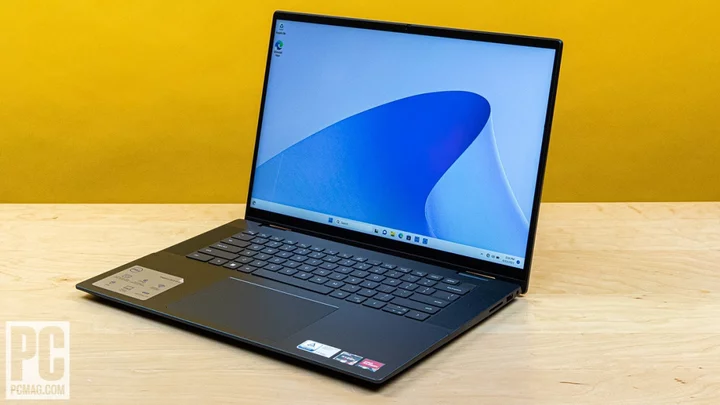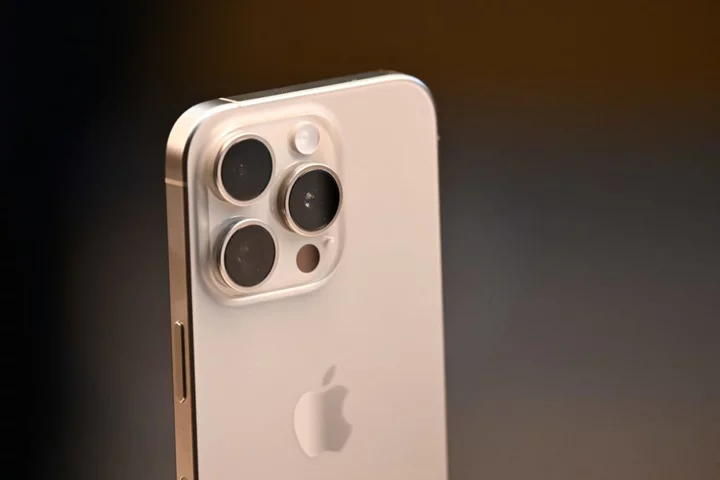Think of 2-in-1 laptops as laptops first and tablets second—a long-distant second in the case of Dell's Inspiron 16 2-in-1, whose AMD-based model 7635 starts at $599.99 ($649.99 as tested). This 16-inch convertible is a real armful if you use it as a tablet, but its flexibility doesn't add a lot of cost over the regular Inspiron 16. Though we like Dell's all-aluminum design and the laptop's almost endless battery life, its merely average display brightness and unsatisfying keyboard hold it back from a higher rating. The Lenovo Yoga 7i 16 Gen 7 and 2021 HP Envy x360 15 are more well-rounded and remain our top choices among big-screen convertibles.
The Design: Anything But Ultraportable
The Inspiron 16 2-in-1 is no lightweight at 4.4 pounds and no shrinking violet at 0.75 by 14.1 by 9.9 inches (HWD), but its slim display bezels suggest it's no larger than it needs to be to accommodate a 16-inch screen with 16:10 aspect ratio. The AMD-based Lenovo Yoga 7 Gen 8 is practically the same size (0.67 by 14.3 by 9.9 inches, 4.5 pounds). Convertibles with old-school 15.6-inch, 16:9-aspect-ratio displays, such as the HP Envy x360 15 (0.72 by 14.1 by 9 inches and 4 pounds), trade vertical screen space for a slightly trimmer profile.
(Credit: Molly Flores)Increasing in popularity, the Inspiron's 1,920-by-1,200-pixel IPS panel has 120 more vertical pixels than the older 1080p or full HD resolution, which translates to seeing about 11% more of a spreadsheet or document without scrolling. The screen supports touch, but its lack of a digitizer layer means it doesn't support active stylus options. Count this Dell out if you planned to doodle in Photoshop.
More unfortunate is the display's low brightness, which squanders its otherwise respectable color reproduction. The Intel version of this laptop—the Inspiron 16 2-in-1 7630; we reviewed the previous but nearly identical Dell Inspiron 7620—includes an OLED display that hikes the price to an eye-watering $1,599.
(Credit: Molly Flores)The Intel model is also distinguishable by its Platinum Silver color as opposed to the Dark River Blue of our AMD unit. Dell kept the design simple, with rounded corners and its familiar logo on the lid. The all-aluminum outside shell affords the Inspiron excellent strength; nowhere I pressed or prodded showed flex. The lid's rigidity is exemplary.
Speaking of the lid, the Inspiron is as unwieldy in tablet mode as you might imagine, but its convertible screen has other uses. Rotating it around 270 degrees yields an easel-like presentation mode that brings the screen closer to you, which I found useful in my lap for tapping through websites and streaming shows. The 2-in-1 is around only $100 more than the non-convertible Inspiron 16 model 5635, which is nearly the same size and only a fifth of a pound lighter.
Connectivity: So-So I/O
The Inspiron 16 2-in-1 has essential ports on its left and right sides, including two 5Gbps USB Type-A ports, two 10Gbps USB-C ports, an HDMI video output, a 3.5mm audio jack, and a full-size SD card reader. Either USB-C port can be used with the included power adapter.
(Credit: Molly Flores)Sadly, the HDMI port is the old version 1.4 and is limited to 1080p rather than 4K output to an external monitor, though USB-C ports support high-resolution DisplayPort output (with an adapter that costs about $15). The Intel-based Inspiron 16 2-in-1 does better by including two USB4 Thunderbolt 4 ports instead of vanilla USB-C, opening possibilities for Thunderbolt docking stations and multiple monitors. That scenario excluded, the 10Gbps USB-C ports have plenty of bandwidth for this laptop's intended uses. The Inspiron also has the latest Wi-Fi 6E and Bluetooth wireless.
(Credit: Molly Flores)The flex and bounce of the Dell's keyboard is disappointing given that the rest of the laptop feels so solid. Short key travel also robs it of tactile feedback, though I still hit 97% accuracy typing at 112 words per minute in the Monkeytype online typing test. The layout is also a mixed bag; you'll find dedicated Home, End, Insert, and Delete keys along the top row, but Page Up and Page Down require pairing the Fn key with the annoyingly half-height up and down arrow keys. At least the two-level white backlighting contrasts well with the dark keys.
For biometric logins, the top right key doubles as the power button and a fingerprint reader. The 1080p webcam doesn't support infrared (IR) facial recognition, though it records a reasonably sharp picture and features a sliding privacy shutter.
(Credit: Molly Flores)The expansive, buttonless touchpad swipes and taps predictably well. Physically pressing the pad to click required more effort than I expected, especially toward the top of the pad.
As for audio, the Inspiron's speakers, which flank the keyboard in the absence of a number pad, get loud but not in a good way. I noticed distortion and overall flatness listening to ELO's "Evil Woman" and Marvel's latest movie trailers. Audio EQ settings in the provided MyDell app do change the sound profile, but they don't make up for the low-quality speakers.
The Inspiron 16 2-in-1 comes with Windows 11 Home and the usual preloaded fare such as WhatsApp and Instagram. You'll also find a 30-day McAfee Antivirus trial. Uninstalling all these took just a few minutes, but ideally, they wouldn't have been included. Dell's standard warranty is one year.
Testing the Dell Inspiron 16 2-in-1: Ample Everyday Pep
Dell's $649.99 Inspiron 16 2-in-1 tested here (discounted $250 on Dell.com at this writing) is the AMD-based model 7635, featuring a six-core Ryzen 5 7530U processor, AMD Radeon integrated graphics, 16GB of RAM, and a 512GB solid-state drive. Its only upgrade over the $599.99 base model is 16GB rather than 8GB of memory, which is worthwhile since RAM can't be upgraded after purchase. A step-up model provides an eight-core Ryzen 7 7730U and twice the storage (1TB) for $849.99. The SSD is user-upgradable.
The Lenovo Yoga 7 Gen 8 commands about the same money ($668 on Lenovo.com for a built-to-order model) while HP's OLED-screened Envy x360 15-fh0097nr was $849.99 direct from HP, which also netted a faster Ryzen 7 CPU and a 1TB SSD. Convertibles running on AMD silicon generally cost less than their Intel counterparts, though the Intel versions tend to provide Thunderbolt 4 ports (an Intel technology).
We filled our performance comparison charts with several large-screen 2-in-1s, including the abovementioned Lenovo Yoga 7i 16 Gen 7 and Intel-based Dell Inspiron 16 2-in-1 model 7620, and the elite Samsung Galaxy Book3 Pro 360. Also included for variety's sake is an ultra-thin clamshell, the Acer Swift Edge 16.
Productivity and Content Creation Tests
We run the same general productivity benchmarks across both mobile and desktop systems. Our first test is UL's PCMark 10, which simulates a variety of real-world productivity and office workflows to measure overall system performance and also includes a storage subtest for the primary drive.
Our other three benchmarks focus on the CPU, using all available cores and threads, to rate a PC's suitability for processor-intensive workloads. Maxon's Cinebench R23 uses that company's Cinema 4D engine to render a complex scene, while Geekbench 5.4 Pro from Primate Labs simulates popular apps ranging from PDF rendering and speech recognition to machine learning. Finally, we use the open-source video transcoder HandBrake 1.4 to convert a 12-minute video clip from 4K to 1080p resolution (lower times are better).
Finally, we run PugetBench for Photoshop by workstation maker Puget Systems, which uses the Creative Cloud version 22 of Adobe's famous image editor to rate a PC's performance for content creation and multimedia applications. It's an automated extension that executes a variety of general and GPU-accelerated Photoshop tasks ranging from opening, rotating, resizing, and saving an image to applying masks, gradient fills, and filters.
The AMD-based Inspiron took the top spot in the main PCMark test; like the others, it had no trouble clearing the 4,000 points we consider a baseline for everyday office productivity. It fell behind in the CPU-specific tests largely because its Ryzen 5 isn't a match for the Ryzen 7 and Core i7 chips in the others, but Dell sells the laptop with a Ryzen 7 if you need extra pep. Most of you should be fine with the Ryzen 5.
Graphics Tests
For general-use laptops, we run two synthetic graphics rendering benchmarks. The first includes two DirectX 12 gaming simulations from UL's 3DMark, Night Raid (more modest, suitable for systems with integrated graphics) and Time Spy (more demanding, suitable for gaming rigs with discrete GPUs). The cross-platform GPU benchmark GFXBench 5, which we use to gauge OpenGL performance, comes next. These GFXBench tests are rendered offscreen to accommodate different native display resolutions; more frames per second (fps) means higher performance.
Integrated graphics are decent for browser-based gaming and perhaps older 3D titles, but none of these laptops came close to qualifying as a gaming machine. The Inspiron 7635 trailed most of the group in our tests. Your only hope to play the latest games on it (or any of these machines) is a streaming service like Nvidia GeForce Now.
Battery and Display Tests
PCMag tests laptop battery life by playing a locally stored 720p video file (the open-source Blender movie Tears of Steel) with screen brightness at 50% and audio volume at 100% until the system quits. Wi-Fi and keyboard backlighting are turned off during the test.
We also use a Datacolor SpyderX Elite monitor calibration sensor and its software to measure a laptop screen's color saturation—what percentage of the sRGB, Adobe RGB, and DCI-P3 color gamuts or palettes the display can show—and its brightness in nits (candelas per square meter) at the screen's 50% and peak settings.
Approaching 18 hours of battery life with a 16-inch screen is outstanding. The AMD Inspiron was arguably the longest-lasting unit here, considering that its screen at the 50% brightness we use for testing was about three times as bright as the Yoga's.
Regardless, I'll repeat that display brightness isn't the 7635's forte, with the lowest peak luminance in this group. The OLED-screened Acer and Samsung made superior showings; naturally, they cost quite a bit more.
(Credit: Molly Flores)Verdict: Above Average Only in Size
The Dell Inspiron 16 2-in-1 (7635) can make a decent family or student PC if you're after a big screen, convertible versatility, and lots of freedom to roam away from AC outlets. Its all-aluminum chassis also impresses in style and strength. The rest of the laptop is just average, however, its sorest points are lackluster screen brightness and a subpar keyboard. We also thought the speakers could have been better and can't understand why the HDMI port is limited to 1080p output. The Lenovo Yoga 7i 16 Gen 7 comes packing a brighter display and equal battery life, and it costs about the same, so it remains a top choice among midrange 16-inch convertibles.









